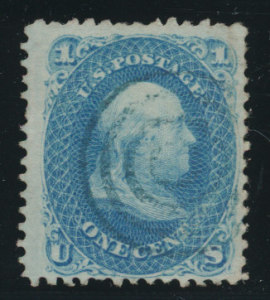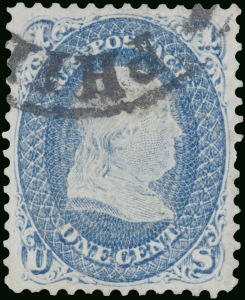$100 or $1,000,000
The reuse of postage stamps was an obsession of postal officials in the mid-nineteenth century. It was the reason that cancellations were used on letters. Still, postal officials in most countries thought this was not enough. They imagined a world of people soaking used postage stamps off envelopes, washing the cancellations either with ink eradicator or with boiling water, and reusing the stamps to defraud the post office of revenue. It was a reasonable fear. A 90¢ stamp in 1857 represented, in purchasing power, the daily wage of an average worker. Various countries addressed the reuse concern differently (Great Britain printed many of their stamps on a chalky paper so the design soaked off in water).
The United States Post Offices devised a technological solution through the use of grills. Grills are applied to stamp paper after the stamps were printed and gummed but before they were perforated. Grilling entails a separate machine and a separate press run. The grilling machine has a series of small knives or pins arranged in a rectangular pattern so that, when applied, the stamp paper is cut with 24-36 tiny ridges in the center of each stamp. The purpose is to make the cancellation ink seep deeply into the paper fibers and make washing cancellations off stamps more difficult.
This was a more or less unique American solution to postage stamp reuse (Peru tried as well for a few years), and it lasted only four years. There is no real evidence that it worked. It was never clear that stamp reuse was a problem that much existed outside the imaginations of officials in Washington, and it is even more unclear that the “solution” had any effect. Still, the grill created many unique varieties and make the United States the only country whose rarest stamp (the one cent Z grill) is a variety that can barely be seen from the front of the stamp.
Serious philatelists from around the world have long had a problem with the grilled US issues. There is no doubt that they were issued for a legitimate postal reason. But should small paper differences matter so much in terms of price? Much has to do with how the catalogs list the stamps. The 2¢ Large Queen of Canada (Scott #24) was issued in 1868 on regular wove paper. It catalogs $95. It was also issued on Laid paper. This paper variety (Scott #32) catalogs $200,000. Similarly, the 3kr 1850 of Austria is known on both wove and laid papers. Because the Europeans don’t collect subtle paper varieties as major catalog numbers, this scarce laid paper catalogs less than 10% of what the Canada stamp catalogs. Next time you read of an enormous price being paid for a US grill, realize that had J. Walter Scott chosen to make #85A a minor variety of #86 (i.e. #86a), it would sell today for a fraction of the $1 million it is supposedly worth today.


